User:Sbb1413/SpaceX landing zones
| This is not a Wikipedia article: It is an individual user's work-in-progress page, and may be incomplete and/or unreliable. For guidance on developing this draft, see Wikipedia:So you made a userspace draft. Find sources: Google (books · news · scholar · free images · WP refs) · FENS · JSTOR · TWL |
SpaceX routinely lands boosters of its Falcon 9 and Falcon Heavy rockets, either on a landing zone on the ground or on a drone ship. As of 2020, 20 Falcon 9 boosters landed on land. The landing zones of SpaceX are Landing Zone 1 (LZ-1), Landing Zone 2 (LZ-4), and Landing Zone 4 (LZ-4). LZ-1 and LZ-2 are situated at Cape Canaveral Air Force Station, while LZ-4 is situated at Vandenberg Air Force Base.
[edit]
Landing Zone 1[edit]
The Landing Zone 1 was built on the site of the former Cape Canaveral Launch Complex 13,[1][2] which has been demolished. The land was leased in February 2015 from the United States Air Force and marked with a stylized X from the SpaceX company logo.[3][4] Four more 150 feet (46 m) diameter pads were initially planned to be built to support the simultaneous recovery of additional boosters used by the Falcon Heavy, although only one extra pad has been built. Planned infrastructure additions to support operations includes improved roadways for crane movement, a rocket pedestal area, remote-controlled fire suppression systems in case of a landing failure, and a large concrete foundation, away from the future three landing pads, for attaching the booster stage when taking the rocket from vertical to horizontal orientation.[4]
After approval from the FAA, SpaceX accomplished its first successful landing at the complex with Falcon 9 flight 20 on December 22, 2015 UTC;[5] this was the 8th controlled-descent test of a Falcon 9 first stage.[6][7] A second successful landing at LZ-1 took place shortly after midnight, local time (EDT) on July 18, 2016, as part of the CRS-9 mission, which was the Falcon 9's 27th flight.[8] The third successful landing was by the CRS-10 mission's first stage on February 19, 2017, which was the Falcon 9's 30th flight.[9] Landing Zone 2 was first used by the maiden launch of Falcon Heavy on February 6, 2018, when the rocket's two side boosters touched down on LZ-1 and LZ-2.[10]
Operations at the facility began after seven earlier landing tests by SpaceX, five of which involved intentional descents into the open ocean, followed by two failed landing tests on an ocean-going platform.[11][12] As of March 2, 2015, the Air Force's sign for LC-13 was briefly replaced with a sign identifying it as Landing Complex.[13] The site was renamed Landing Zone prior to its first use as a landing site.[14][6] Elon Musk indicated in January 2016 that he thought the likelihood of successful landings for all of the attempted landings in 2016 would be approximately 70 percent, hopefully rising to 90 percent in 2017, and cautioned that the company expects a few more failures.[15]
Landing Zone 2[edit]
In July 2016, SpaceX applied for permission to build two additional landing pads at Landing Zone 1 for landing the boosters from Falcon Heavy flights.[16]
In May 2017, construction on a second, smaller pad began, called Landing Zone 2. This pad is located about 310 meters to the northwest of the first pad and is used for landing Falcon Heavy side boosters.[17] By June 2017, the landing pad was modified with a radar reflective paint, to aid with landing precision.[18]
Vandenberg Air Force Base[edit]
Landing Zone 4[edit]
SpaceX signed a five-year lease of Vandenberg Space Launch Complex 4W in February 2015, in order to use the area to land reusable launch vehicles at the pad. The location is being used for vertical landing of Return-To-Launch-Site (RTLS) first-stage boosters of the Falcon 9 rockets that are launched from the adjacent SLC-4E launch pad.[19][20] This novel use of SLC-4W had initially surfaced in July 2014 when NASASpaceFlight.com published that SpaceX was considering leasing SLC-4W for use as a RTLS vertical-landing facility for reusable first-stage boosters.[21] The pad was constructed, and subsequently first used for a rocket booster landing of a first stage of a Falcon 9 launch vehicle in October 2018, recovering the booster that had just launched the Argentinian SAOCOM 1A satellite.[19]
Principal structures on the launch pad were demolished in September 2014 as construction of the landing pad began.[22]
It was initially thought that the booster used to launch of a fourth batch of ten Iridium NEXT satellites in December 2017 would be the first to land at VAFB[23] but this mission was ultimately performed in expendable mode.[24] In July 2018, SpaceX applied for a permit to the Federal Communications Commission (FCC) for post-landing communications with a first stage of a Falcon 9 rocket at SLC-4W, pointing to a possible landing sometime in September, possibly for the SAOCOM 1A mission[25] although this was later rescheduled for October 8 (UTC). A few weeks prior to this first landing attempt it was known to the public, again via FCC permits and also public warnings about sonic booms in the area, that SpaceX had renamed this pad as Landing Zone 4.[19]
Landing statistics[edit]
Landing outcomes[edit]1
2
3
4
5
6
2015
2016
2017
2018
2019
2020
|
Landing sites[edit]1
2
3
4
5
6
2015
2016
2017
2018
2019
2020
|
Landing history[edit]
| Date (UTC) | Mission | Launch vehicle Booster ID |
Flight № | Landing Zone | Landing | Result | ||
|---|---|---|---|---|---|---|---|---|
| December 22, 2015 | OG2-F2 | Falcon 9 Full Thrust B1019 |
20 | LZ-1 | 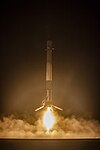 |
Success | ||
| July 18, 2016 | SpaceX CRS-9 | Falcon 9 Full Thrust B1025 |
27 | LZ-1 | 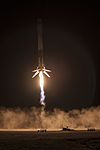 |
Success | ||
| February 19, 2017 | SpaceX CRS-10 | Falcon 9 Full Thrust B1031 |
30 | LZ-1 | 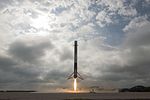
|
Success | ||
| May 1, 2017 11:24 | NROL-76 | Falcon 9 Full Thrust B1032 |
33 | LZ-1 | 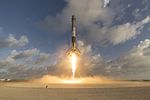
|
Success | ||
| June 3, 2017 | SpaceX CRS-11 | Falcon 9 Full Thrust B1035 |
35 | LZ-1 | 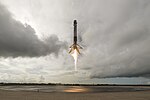
|
Success | ||
| August 14, 2017 | SpaceX CRS-12 | Falcon 9 Full Thrust B1039 (Block 4) |
39 | LZ-1 | 
|
Success | ||
| September 7, 2017 | OTV-5 (X-37B) | Falcon 9 Full Thrust B1040 (Block 4) |
41 | LZ-1 | 
|
Success | ||
| December 15, 2017 | SpaceX CRS-13 | Falcon 9 Full Thrust B1035 |
45 | LZ-1 | 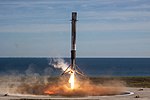
|
Success | ||
| January 8, 2018 | Zuma | Falcon 9 Full Thrust B1043 (Block 4) |
47 | LZ-1 | 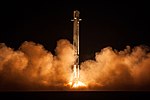
|
Success | ||
| February 6, 2018 | Elon Musk's Tesla Roadster | Falcon Heavy B1023, B1025 |
FH-1 | LZ-1 B1023 |
LZ-2 B1025 |

|
Success B1023 |
Success B1025 |
| October 8, 2018 | SAOCOM 1A | Falcon 9 B5 B1048.2 |
62 | LZ-4 | 
|
Success | ||
| December 5, 2018 | SpaceX CRS-16 | Falcon 9 Block 5 B1050 |
65 | LZ-1 | Failure (Landed in ocean) | |||
| April 11, 2019 | Arabsat-6A | Falcon Heavy B1052, B1053 |
FH-2 | LZ-1 B1052 |
LZ-2 B1053 |

|
Success B1052 |
Success B1053 |
| June 12, 2019 | RADARSAT Constellation | Falcon 9 B5 B1051.2 |
72 | LZ-4 | 
|
Success | ||
| June 25, 2019 | STP-2 | Falcon Heavy B1052, B1053 |
FH-3 | LZ-1 B1052 |
LZ-2 B1053 |

|
Success B1052 |
Success B1053 |
| July 25, 2019 | SpaceX CRS-18 | Falcon 9 Block 5
B1056 |
73 | LZ-1 | 
|
Success | ||
| March 7, 2020 | SpaceX CRS-20 | Falcon 9 Block 5
B1059 |
82 | LZ-1 | Success | |||
| August 30, 2020 | SAOCOM 1B | Falcon 9 Block 5
B1059.4 |
92 | LZ-1 | Success | |||
References[edit]
- ^ "45th Space Wing, SpaceX sign first-ever landing pad agreement at the Cape" (Press release). 45th Space Wing Public Affairs. February 10, 2015. Retrieved February 10, 2015.
- ^ Gruss, Mike (February 10, 2015). "SpaceX Leases Florida Launch Pad for Rocket Landings". Space.com. Retrieved February 12, 2015.
- ^ Davenport, Christian (December 21, 2015). "Elon Musk's SpaceX returns to flight and pulls off dramatic, historic landing". The Washington Post.
- ^ a b "Draft Environmental Assessment for the Space Exploration Technologies Vertical Landing of the Falcon Vehicle and Construction at Launch Complex 13 at Cape Canaveral Air Force Station Florida" (PDF). USAF. October 2014. Archived from the original (PDF) on January 8, 2015. Retrieved December 23, 2015.
- ^
Graham, William (December 21, 2015). "SpaceX returns to flight with OG2, nails historic core return". NASASpaceFlight.com. Retrieved December 21, 2015.
During Monday's launch, the first stage made its historic return to LZ-1 and successfully landed in a milestone event for SpaceX.
- ^ a b "Rocket landing at Cape Canaveral planned after SpaceX launch". SpaceflightNow. December 19, 2015. Retrieved December 21, 2015.
- ^ Dean, James (December 1, 2015). "SpaceX wants to land next booster at Cape Canaveral". Florida Today. Retrieved December 2, 2015.
- ^ SpaceX launches space station docking port for NASA, The Associated Press, July 18, 2016
- ^ Clark, Stephen (February 19, 2017). "Historic launch pad back in service with thundering blastoff by SpaceX". Spaceflight Now. Retrieved March 5, 2017.
- ^ Gebhardt, Chris (February 6, 2018). "SpaceX successfully debuts Falcon Heavy in demonstration launch from KSC – NASASpaceFlight.com". NASASpaceFlight.com. Retrieved February 7, 2018.
- ^ James Dean (January 6, 2015). "SpaceX to try landing booster on a sea platform". Florida Today. Retrieved February 8, 2015.
- ^ Graham, William (February 8, 2015). "SpaceX Falcon 9 ready for DSCOVR mission". NASASpaceFlight.com. Retrieved February 8, 2015.
- ^ "SpaceX - SpaceX's Photos - Facebook". facebook.com.
- ^
Bergin, Chris (December 18, 2015). "SpaceX Falcon 9 Static Fires ahead of OG2 RTF mission". NASASpaceFlight.com. Retrieved December 19, 2015.
All that is currently known for this mission is SpaceX's ambition to conduct a historic landing on its new Cape Canaveral landing pad, officially known as LZ-1 (Landing Zone -1), but also tagged "X.
- ^ Elon Musk [@elonmusk] (January 19, 2016). "My best guess for 2016: ~70% landing success rate (so still a few more RUDs to go), then hopefully improving to ~90% in 2017" (Tweet) – via Twitter.
- ^ Santana, Marco (July 18, 2016). "SpaceX seeks approval for two additional landing pads on Space Coast". Orlando Sentinel. Retrieved July 20, 2016.
- ^ "LZ-1 to LZ-2 distance estimate". imgur. JerWah. Retrieved September 12, 2018.
- ^ Elon Musk [@elonmusk] (June 4, 2017). "@Pandora659 Yeah, pretty much dead center. We painted the target area with radio reflective paint, which helps the radar be more precise" (Tweet) – via Twitter.
- ^ a b c "SpaceX Falcon 9 launches with SAOCOM 1A and nails first West Coast landing". October 7, 2018. Retrieved October 8, 2018.
- ^ Clark, Stephen (February 17, 2015). "SpaceX leases property for landing pads at Cape Canaveral, Vandenberg". Spaceflight Now. Retrieved February 19, 2015.
- ^
Bergin, Chris (July 28, 2014). "SpaceX Roadmap building on its rocket business revolution". NASAspaceflight. Retrieved July 28, 2014.
At this point, we are highly confident of being able to land successfully on a floating launch pad or back at the launch site and refly the rocket with no required refurbishment
- ^ SpaceX Demolishes SLC-4W Titan Pad. YouTube. September 18, 2014. Retrieved September 3, 2015.
- ^ Gebhardt, Chris (October 16, 2017). "SpaceX adds mystery "Zuma" mission, Iridium-4 aims for Vandenberg landing". NASASpaceFlight.com. Retrieved October 17, 2017.
- ^ Gebhardt, Chris (December 22, 2017). "SpaceX close out 2017 campaign with Iridium-4 launch – NASASpaceFlight.com". NASASpaceFlight.com. Retrieved February 27, 2018.
- ^ Gebhardt, Chris (July 6, 2018). "SpaceX, ULA near-term manifests take shape, SpaceX aims for 1st RTLS at Vandenberg – NASASpaceFlight.com". NASASpaceflight.com. Retrieved July 9, 2018.

